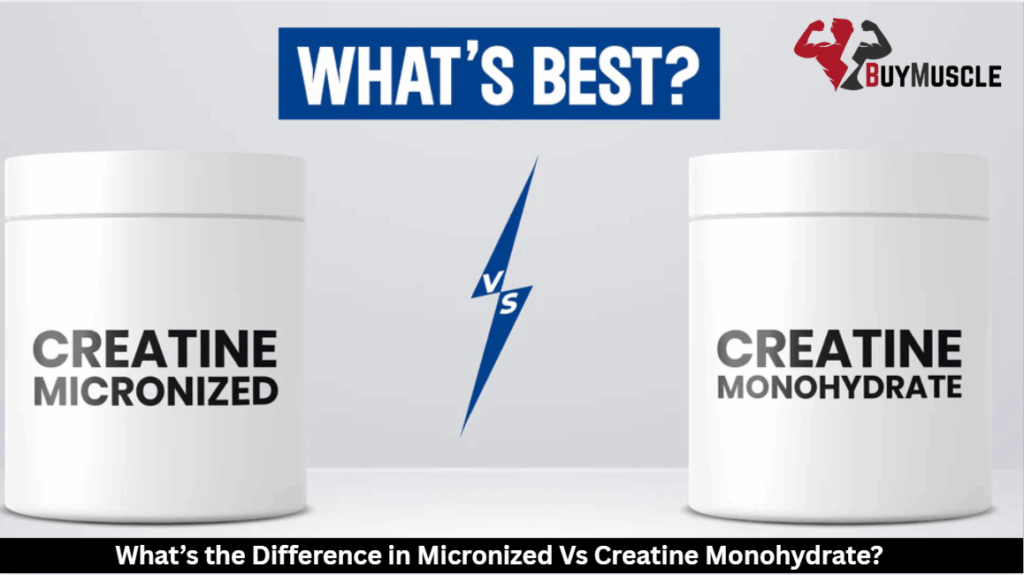You’ve probably seen both micronized creatine and standard creatine monohydrate on supplement store shelves, but understanding their differences isn’t always clear. When you’re investing in supplements, the seemingly minor distinctions between these two forms can impact your training results, comfort, and wallet.
Is the micronized version worth the typically higher price tag? Does it actually absorb better or reduce those uncomfortable bloating effects? The answer isn’t as straightforward as marketing claims might suggest.
What is Creatine Monohydrate?
Creatine monohydrate stands as the gold standard in sports supplementation, consisting of a creatine molecule bound to a water molecule. It has earned this reputation through decades of research confirming its ability to improve muscle performance and power output during high-intensity activities.
The supplement works by increasing your body’s phosphocreatine stores, which help regenerate ATP. Most users follow a loading phase (20g daily for 5-7 days) before shifting to a maintenance dose (3-5g daily) to maximize absorption rates.
When shopping for creatine monohydrate, purity level matters greatly. Look for products that are independently tested and contain minimal additives. Despite newer creatine variations on the market, monohydrate remains the most studied, cost-effective option with proven results.

What Does “Micronized” Mean?
The term “micronized” refers to a specialized manufacturing process where standard creatine monohydrate particles have much smaller sizes. This process creates micronized creatine with particles up to 20 times smaller than regular monohydrate, dramatically improving its solubility in liquids.
When you mix micronized creatine with water or your favorite beverage, you’ll notice less settling and clumping at the bottom of your glass. The enhanced mixing quality isn’t just about convenience. It may actually benefit your body. The reduced particle size can decrease gastrointestinal side effects that some users experience with standard monohydrate, such as bloating or stomach discomfort.
If you’ve struggled with digestive issues from regular creatine, the micronized version might offer a more comfortable supplementation experience while delivering the same performance benefits.

Absorption and Bioavailability Differences
Beyond particle size differences, understanding how your body processes different creatine forms reveals important distinctions. Micronized creatine dissolves more completely in liquids, potentially enhancing its bioavailability compared to standard monohydrate. This improved solubility may lead to more efficient uptake during digestion.
However, research shows both forms ultimately achieve similar muscle saturation levels once absorbed. What sets them apart is the speed at which they break down and pass through the digestive system; for those sensitive to standard monohydrate, micronized versions might reduce gastrointestinal discomfort without altering your dosing protocol.
Remember that individual responses vary. While micronized creatine’s improved mixability offers practical advantages, the effectiveness of your creatine supplementation depends more on consistency than particle size once your muscles have fully absorbed the compound.
Effectiveness for Muscle Gains and Performance
When comparing performance outcomes between micronized and standard creatine monohydrate, you’ll find minimal differences in their ability to enhance muscle development. Both supplement forms effectively increase phosphocreatine stores in your muscles, supporting strength gains and improved workout recovery regardless of which you choose.
The training response your body experiences depends more on consistent supplementation than the specific creatine variant. Research shows that both forms contribute similarly to increased power output during high-intensity exercise. While some users report differences in water retention between the two types, these effects vary by individual and don’t greatly impact overall performance benefits.
What matters most is taking your creatine daily and maintaining proper hydration. The specific form is secondary to your commitment to the supplementation protocol.

Side Effects and Digestive Tolerance
Although both forms of creatine are generally safe, digestive tolerance can vary considerably between individuals. Standard creatine monohydrate can be a bit rough on the stomach for some lifters. Its larger particles never dissolve well. You might feel bloated or crampy after your shake.
A smoother option is micronized creatine. The smaller particles blend in water and are gentler on your gut. This version may be easier on the stomach if regular creatine has always troubled you before.
Whatever you pick, don’t skimp on hydration. Drinking enough water helps your body handle creatine more efficiently and keeps side effects in check. Starting with a low dose can also give your system time to adjust if you’re new to or sensitive to supplements.
Choosing the Right Form for Your Needs
Choosing between micronized creatine and standard monohydrate comes down to how your body responds and what you value most. If you’re just getting started with creatine, the classic monohydrate is a solid, budget-friendly choice that is effective time and time again.
The smaller particle size of micronized creatine mixes better and may cause fewer digestive issues. Did you have stomach problems with regular-sized meals? Try micronized meals.
No matter which you go with, go for products with third-party testing for purity, quality, and safety. That peace of mind is always worth it.
Frequently Asked Questions
Does Micronized Creatine Cost More Than Regular Monohydrate?
Yes, micronized creatine typically costs more than regular monohydrate. You’ll pay a premium for the additional processing that creates smaller particles, though the price difference isn’t usually dramatic for most brands.
Can Women Take Micronized Creatine Safely?
Yes, you can take micronized creatine safely as a woman. It’s equally effective and safe for women as it is for men. There’s no gender-specific reason to avoid either form of creatine supplementation.
How Long Does It Take to See Results With Either Form?
You’ll typically notice initial results in 1-2 weeks with either form of creatine. Full benefits come after up to 6 weeks of consistent use. Water retention may occur earlier, while strength and performance gains develop gradually.
Should I Cycle off Creatine Periodically?
Cycling off creatine isn’t necessary. You can safely take it long-term without breaks. Research shows no benefits to cycling, and your body naturally produces creatine anyway. Consistent daily intake provides the best results.
Can Vegetarians Get Enough Creatine Without Supplementation?
No, you can’t get enough creatine without supplements as a vegetarian. Your body makes some creatine naturally, but most dietary creatine comes from meat and fish, which you’re not consuming in your diet.








